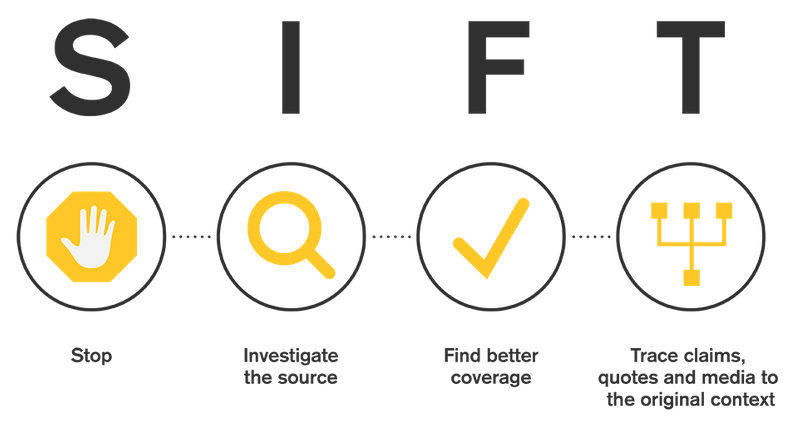Picture this... 💭
You're working on a research school project about climate change effects and came across a website saying:
Climate change is a myth! Polar bear numbers are increasing, they are becoming smaller due to eating less food.

You find the information surprising and start thinking, How can I be sure this information isn't false? 🤔
Don't worry, there is an easy method to check online information.
Make sure your research is based on facts, not false information, with the SIFT method!
Spot reliable information online with the SIFT method

Alright, so let's go back to our earlier scenario: you found a website saying that climate change is a myth, and you're not sure if it is true or not.
To figure this out, use the SIFT method!
What is the SIFT method, you may ask?
The SIFT method is a helpful tool for researching whether online content can be trusted.
It was created by digital literacy expert Mike Caulfield. It has 4 steps:
Stop
Investigate the source
Find better coverage
Trace claims, quotes, and media to the original content
 Image by UChicago Library. To hear an audio version of the information in the image above, click the play button on the audio player below:
Image by UChicago Library. To hear an audio version of the information in the image above, click the play button on the audio player below:

Follow the next step-by-step guide to learn how to use the SIFT method when doing research for a project.
Step 1: Stop ✋

Before you read the article saying that climate change is a myth, stop for a moment and ask yourself:
How do I feel when I read this information?
Example: I feel confused and unsure.
What do I already know about climate change? Does this information about polar bears align with what I already know?
Example: I've learned at school that climate change is real and that polar bears are struggling because the ice is melting in the Arctic. So this information about polar bears becoming smaller for lack of food doesn't match what I've learned.
Do I know this website or author?
Example: I don't recognize this website, and the domain ending seems strange: .biz.

Tip: Check the WHOIS information to find out who owns the website and when it was registered.📍
Step 2: Investigate the source 🔍

After stopping, the next step is to investigate where the information came from and who created it. Use these questions to guide you in this step of the SIFT method:
Who wrote this information? Can I find more information about the authors/creators online?
Example: The website doesn't say who wrote this information but when I searched on Google, I did find the organization on Wikipedia.
What are their goals? Are they trying to persuade me about this topic?
Example: The organization may want to persuade me by saying that climate change is not real.
Do they have any biases towards the topic?
Example: I found that the organization is sponsored by The Heritage Foundation. This institute is a climate denial organization founded by Exxon Mobil, a big American gas and oil company.
Are the authors experts in the field?
Example: The organization says they're a group of journalists, not environmental scientists.

Tip: Use lateral reading to check the source's opinions from other reliable sources. You can search Google or Wikipedia to learn more about an author or organization. 📍
Step 3: Find better coverage 📚

Now that you've investigated the website, it's time to find out if other sources agree or disagree with the original claim: climate change is a myth.
Here are some questions to guide you in this step of the SIFT method:
Can I find other sources that support that climate change is a myth and that polar bears are increasing their population?
Example: I tried to find other websites agreeing with the claim that Climate change is a myth but most sources say the opposite, that climate change is real and is affecting polar bears negatively.
What other sources are available on the topic of climate change?
Example: I found information about climate change from trusted sources like NASA, and the Royal Society.
Are there trusted news sources reporting this claim about polar bears?
Example: I looked at reputable news websites like BBC and Reuters, but they haven't reported that the population of polar bears is increasing due to climate change.

Tip: Use nonpartisan, non-profit fact checker websites like Snopes, AFP Fact Check, or the Washington Post fact checker to see what they say about the topic you're researching. 📍
Step 4: Trace claims, quotes, and media to their original context 🧑💻

The final step is about checking the accuracy and context of the claims by looking into their original sources.
Here are some questions to help you with this step of the SIFT method:
Does the information include references to where it originally came from?
Example: The website doesn't provide links or sources where they got the information about the polar bear population increasing due to climate change.
Does the original source of information back up what the website is saying?
Example: I didn't find any original source for this claim. Most sources I found say that Polar bears are at risk because the ice in the Arctic is melting.
Is the information being used correctly, or is it taken out of context?
Example: It seems that this website is twisting the information. Polar bears are actually struggling because of climate change, and their numbers aren't increasing because of it.
Have other experts in the field looked at the original source (aka peer-reviewed)?
Example: This website's content doesn't seem to have been reviewed by experts, and credible sources that have been checked disagree.

Tip: Watch out for red flags in what you see online when doing research. Disinformation is designed to provoke strong emotions like shock, anger, or fear.
If the information you're reading makes bold claims, seems too good to be true, or uses clickbait titles like You won't believe this, consider fact-checking it. 📍
Quiz
You found a website saying that eating one piece of dark chocolate daily increases memory by 50%. Which step of the SIFT method would help you check if this information is legit for your research project?
Take Action

There's tons of information on the web, and it can be hard to tell which online content can you can trust when doing research.
Here are some things you can do to make this process easier and improve your online verification skills with the SIFT method:
Your feedback matters to us.
This Byte helped me better understand the topic.
